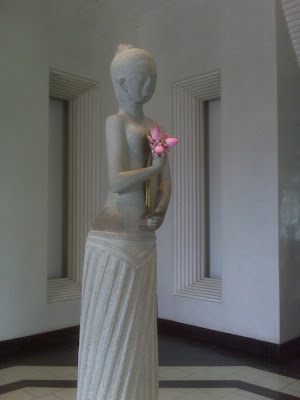Bantay Srei and the Legacy of Andre' Malraux
One of the temple sites that I was particularly interested in visiting was Bantay Srei, which is located about an hour outside of Siem Reap.
Bantay Srei holds a particular fascination for me because of the influence this temple had on the life of Andre' Malraux -- the adventurer, author, and one-time Minister of Cultural Affairs in France during the administration of Charles de Gaulle. As a student during the Viet Nam War, I became interested in Malraux as an example of someone who turned art into action. He not only wrote one of the most influential books of his time Man's Fate (La Condition Humaine). He was an acknowledged mytho-maniac, but he was also instrumental in re-forming the French perspective on Colonialism.
Malraux experiences in what was then called Indochina started when -- as a young man -- he came to Cambodia with the expressed purpose of finding Bantay Srei -- which previous French explorers had misplaced and confused with another site back in the 1920s. According to some historians, Malraux was a self-taught fanatic about art and culture, and he was intrigued with the legends of Bantay Srei's beautiful bas relief carvings. When the stock market crashed in 1922, leaving he and his new bride penniless, he determined to regain their economic stability by bringing examples of those temple carvings to France and selling them to museums (a form of commerce that was already well-established.) He deeply researched the known literature, pouring over the maps and recorded legends and stories of the Angkor area. Then he borrowed money to mount an exploration.
Unfortunately, so the story goes, while he was traveling to Cambodia on a trunk steamer, the colonial powers in Indochina passed a law prohibiting this kind of activity -- the first effort to preserve the temples in Cambodia from opportunists like Malraux. When Malraux arrived, he ignored this law and proceeded to mount his expedition. After several days of moving through the jungle, they found the temple, and his crew cut into the sandstone and removed several of the bas reliefs --cutting into the temple with hand saws. Fortunately, he was turned in to authorities and jailed -- sentenced to death.
When the French intelligentsia learned of his fate, a movement was started to get Malraux pardoned, and after many months in jail, he was released. The experience, however, radicalized him, and he went on to form an anti-colonial newspaper in Vietnam called "Indochina in Chains" -- one that the government attempted to shut down on several occasions and co-founded the Young Annam League -- a proto-Communist organization. His experiences in seeking Bantay Srei were fictionalized in what Malraux called an "anti-memoir" entitled "The Royal Way." While working in Vietnam, he wrote his second novel called "Man's Fate" -- a novel that predicted the Chinese Revolution and idealized the political struggles of the disenfranchised peasants in China. He wrote this novel without ever having visited China, yet its influence on the French intellectual community was profound.
Malraux went on to fight in the Spanish Civil War and in the French Resistance during WWII. He was captured twice, and sentenced to death on one occassion. He became such a towering "heroic" intellectual figure in France that his influence deeply impacted how the French Governments began to deal with its former colonial holdings. Like many, I admired Malraux's intelligence, his activist sentiments, and his deep concern with art and the rights of disenfranchised. (He wrote many books on art and culture that, in some people's mind, were the first look at global artistic cultural movements.)
That being said, in Cambodia Malraux is understandably portrayed as a villain for his desecration of Bantay Srei -- an example of the thieving nature of European opportunists who care nothing for the heritage of the Cambodian people. Even at the Cambodian Royal Palace they have a video display where they comment on Malraux's exploits, characterizing him as a simple theif.
This got me thinking about Malraux's influence again, and how that played out during the Khmer Rouge' days, when France embraced the regime and ignored -- as many western countries ignored -- the evidence of the auto-genocide. Did Malraux's preoccupation with populist peasant revolutions damper an awareness of the dangers of the Khmer Rouge'?
In Francois Bizot's excellent memoir of the fall of Phenom Penh "The Gate", he relates how he had tried to inform a well-known French journalist of what was going on -- based upon his own personal experience as a captive of the Khmer Rouge'. Bizot, in 1975, had first-hand knowledge of the tortures and executions of innocent people by the Khmer Rouge', and he later ended up being the only Western captive that was ever released by them. The French journalist who Bizot was trying to inform would have none of it. It was as though a veil of a "politically correct sentiment" had been dropped over the workings of the Khmer Rouge' regime, and the French intelligentsia could not or would not pass judgment on a populist Communist peasant revolt.
This reference in "The Gate" caused me to wonder if the influence of Malraux's radicalization fifty years before was still being reflected in the minds of people who should have known better. At that time -- in 1975 (Malraux died in 1976) -- Malraux's influence was still being felt, along with a lot of naive sentiments about Indochina.
In any event, Bantay Srei had proven to be a subtle and immutable influence in my own thinking, emanating out of my readings of Malraux, long before this trip. So actually seeing the temple was -- for me -- a really important event. The actual visit was not a disappointment at all.
The temple, in size, is extremely small when compared to Angkor Wat. Yet the carvings and decorations are so exquisite that they dwarf the artistic workmanship of any of the other temples we visited. We found ourselves walking around in awe of its beauty. So unique are the qualities of these bas reliefs that, when one sees them out of context -- such as in the museum at Siem Reap -- they are immediately recognizable.
I remember saying to Judith that -- if Malraux was destined to steal from a temple -- at the very least he knew he should steal from only the most exquisite. But for an intellectual, his lack of a moral compass may have idealized the human struggle for peace and justice, and the resulting silence may have ultimately had a significant effect on the lives and deaths of many people in the era of the Khmer Rouge'.












